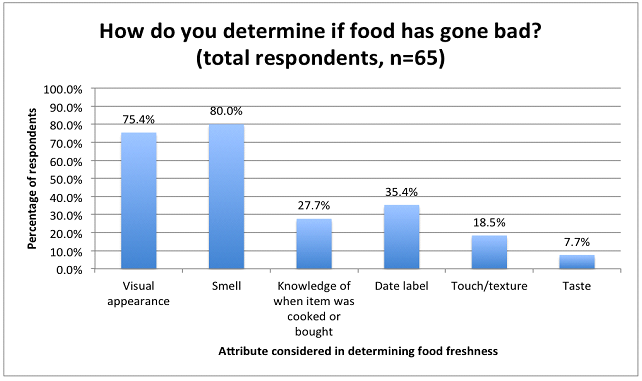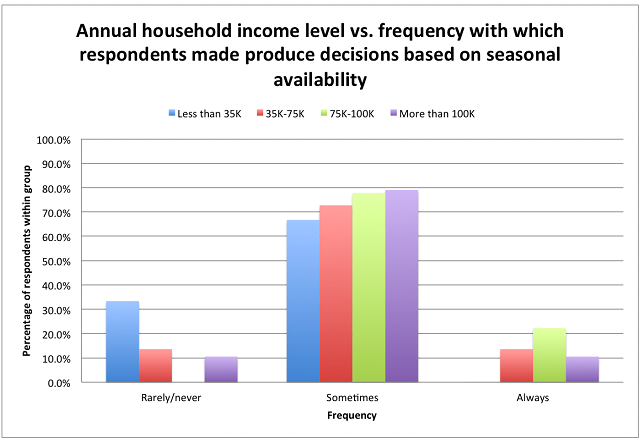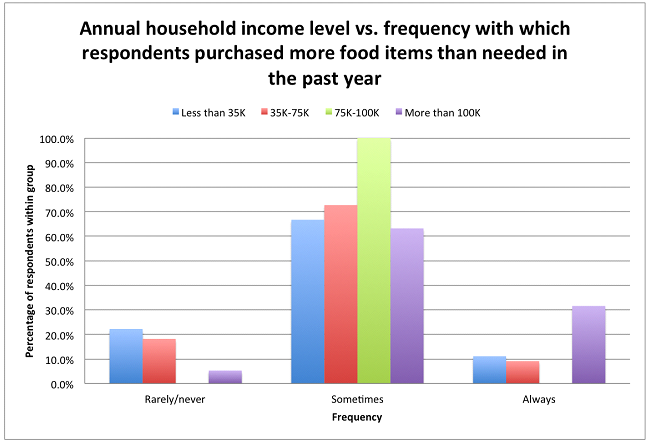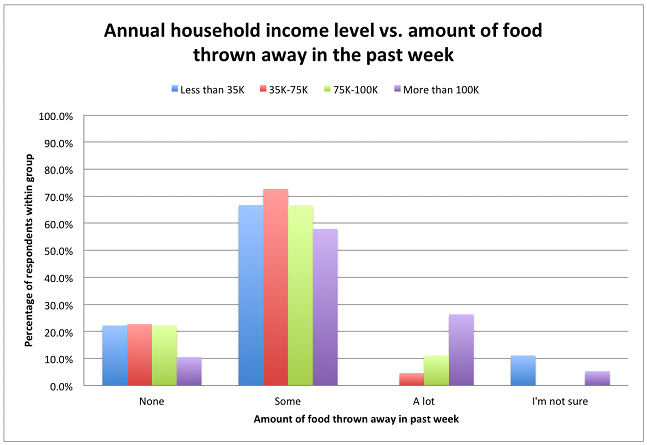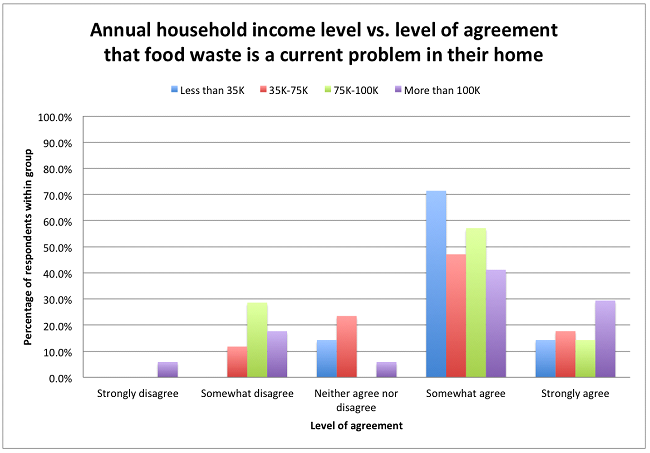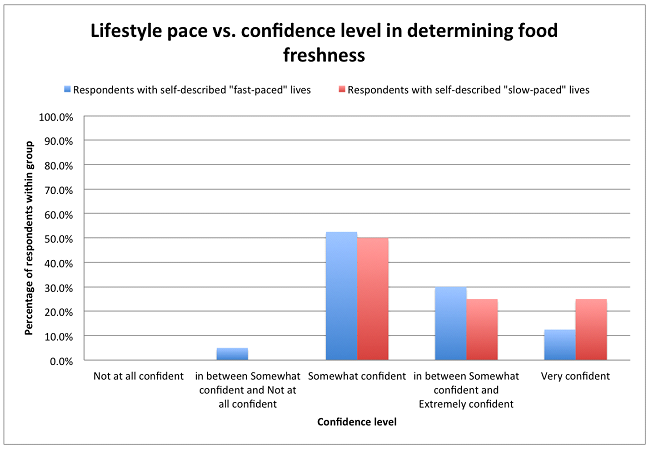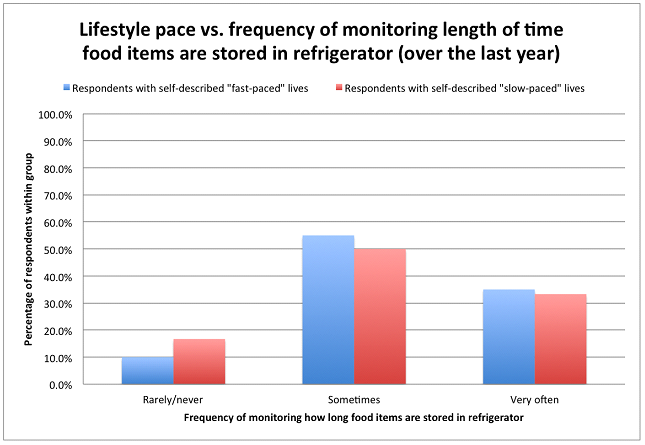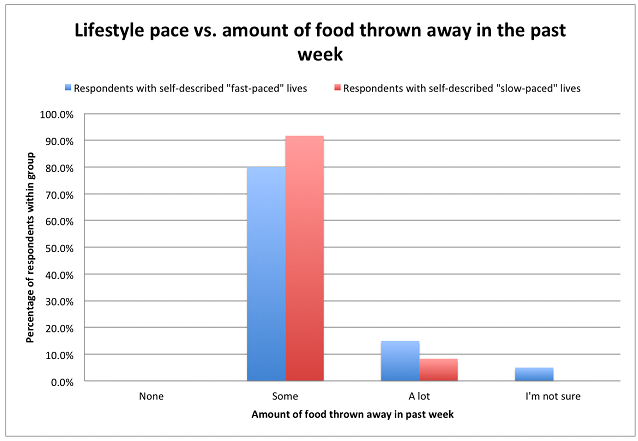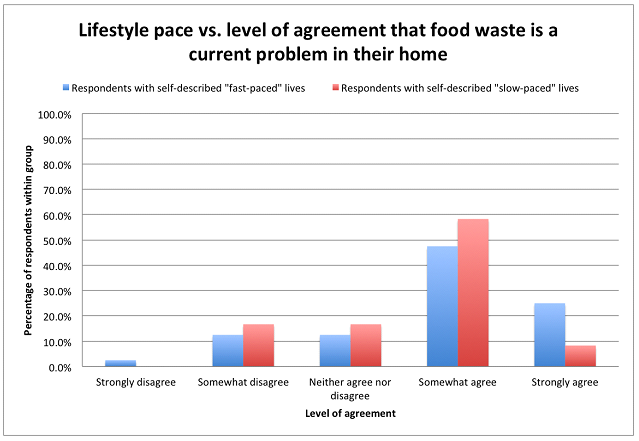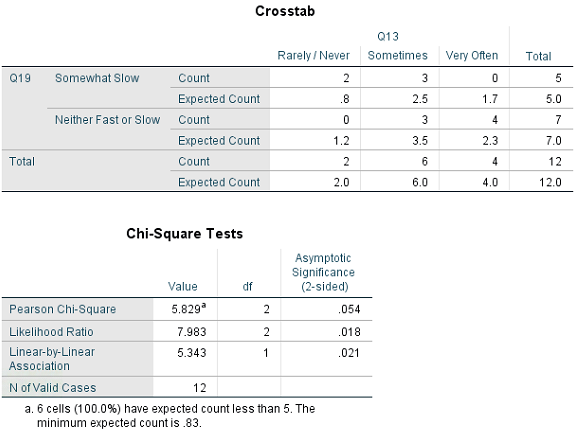House Hold Food Waste
House Hold Food Waste
Contextual Inquiry & Use Analysis
As part of a graduate school research team, we looked at the problem of household food waste and it's impact on society and the environment. Below is the project including: observation, data collection, analysis, interviews, surveys, and study conclusion.
In January 2017, we observed four participants as they reviewed the contents of their refrigerators and other food storage areas (such as pantries) and determined which food items to throw away. We took field notes of the observations.
We organized our findings into clusters that defined the food waste behaviors we observed. The most wasteful product groups were dairy products, fresh fruits/vegetables, and home-cooked items. Among our participants, there was a moderate level of wasteful interactions (29% of food wasted). However, our sample size is small and we only observed over a short period of time.
In February 2017, we explored this problem in more depth through interviews with four participants. We interviewed the four about their grocery shopping and cooking habits, and their attitudes and methods around preserving food or using it before it goes to waste.
Through our interviews, we identified four major themes: consumerism-- focused on how much guilt the participant felt about the culture of buying and selling; consciousness of personal waste-- identified through participant’s acknowledgement, or lack thereof, of their own wasteful actions; busy lifestyle-- participants tended to blame their choice (that led to wasteful behavior) on their fast-paced, busy lives; and preparedness-- focused on the amount of effort the participant expressed towards reducing waste in their household. The four interview participants fell relatively close together on the spectrums created to visually represent these themes; the greatest range between them was visible on the preparedness spectrum. We decided to explore these themes further in an online survey, which would give us access to a larger sample.
We conducted an online survey (using SurveyMonkey) in March 2017. We recruited participants through DePaul’s CDM and COMM Participation Pool, as well as through the DePaul HCI Facebook group, and our personal social networks on Facebook and Twitter. A total of 67 people took the survey. In addition to getting a deeper understanding of why and how people waste food at home, we sought to test our main hypothesis that people with more fast-paced lives exhibit more food waste behavior. We used a Chi Square test to check for a correlation between the independent variable (question 19 focused on lifestyle pace) and 4 other response variables (questions 11, 13, 15 and 20 focused on direct household food waste). We found a statistical correlation between three of the response variables and the independent variable, which supports our hypothesis that lifestyle pace creates more food waste behavior.
Our survey showed us date labels were not the leading determinant in people’s decisions to throw away food. Rating potential methods to reduce waste, survey respondents felt “better meal planning” would be the most useful method overall, with “freezing food before it expires” being the second most useful. A technological solution may not assist in the doing of the activities, but could serve to remind busy people to complete small tasks that make shopping, cooking and managing food easier, or it could give them resources that make those tasks faster, cheaper and/or more efficient. Future work (particularly via survey) could explore trends within certain demographic groups, such as varying income levels, in greater depth.
A report by the Natural Resources Defense Council (NRDC 2012) found that up to 40% of the food, from farm to fork, in the United States goes wasted. Food waste contributes to increased greenhouse gas (GHG’s) emissions (USDA 2014). It has been estimated that if the food waste was gathered to create a country, it would be the third largest polluter of GHG’s in the world (USDA 2014). Further, food waste consumes 21% of all freshwater (FAO 2013), $218 billion dollars for production and disposal (USDA 2014), while 48 million people lived in food insecure-households in 2014 (USDA 2015). A reduction of 15% in household food waste would be enough to feed more than 25 million Americans each year (NRDC 2013).
Premature expiration dates contribute to food being disposed of prior to the product being inedible (NRDC 2013). Clarification and standardization of food expiration labels would go a long way towards helping consumers make better decisions on which foods to discard and which foods are safe to consume (NRDC 2013). Studies have found that up to a third of people surveyed throw food away based on expiration dates without knowing if the food is truly beyond it’s “best before” threshold (USDA 2014). Based on the research, 30% of food waste is avoidable (NRDC 2013). Certain items were found to be gross contributors to household waste: fruits & vegetables, meats, and breads.
Our focus in this project was to identify mechanisms by which household food waste is generated; we aimed to explore implications of the design for persuasive computing that will assist users in lowering their overall household food waste. Specifically, we asked what are the requirements for a technology that would help people reduce their food waste?
We found two competitors: (1) Freshbox and (2) Best Before.
- Freshbox is an app that allows for tracking of food expiration dates.
The app is focused on presenting users with a means to track expiration dates using photos; the app rewards users with badges. However, we felt the app was just a lightweight notification system; i.e., it does not include features to help adjust “throw away” behavior of household users. - Best Before is similar to Freshbox, but with an additional feature—it allows users to track the food’s location within the refrigerator as well as its expiration date. This app also does not have any features to computationally adjust the behavior of users.
Both applications focus on one narrow aspect of the culture of food waste--expiration dates and labeling. However, researchers have found that three main components affect household food waste: Injunctive Norms (the perception by which users decide if behavior is approved or disapproved by their society), Moral Norms (how society indicates we should exercise freedom), and Perceived Behavioral Control (the perception of the difficulty of achieving a stated behavior) (Aarhus University 2015). When people had social evidence to support the idea that they should not waste food, Injunctive Norms (i.e. what society says we should do about food waste), there was less food waste. We argue that a persuasive technology aimed at food waste reduction should leverage injunctive norms and provide educational tips about how to waste less.
In the next sections we present our research methods, findings, and discuss the implications for the design of technology aimed at food waste reduction.
We conducted four in-home observations of participants as they cleaned out their refrigerators and pantries. We also asked about their grocery shopping and lifestyle (eating, cooking, ordering food) habits. We aimed to understand the criteria by which participants determine when food is bad and how they made those decisions. In the next sections we present our participants, and our data collection and analysis methods.
- Participants
Observations were conducted with four females who were between the ages of 30-80 years old. Participants were recruited through social connections. Inclusion criteria included (a) a household size greater than two; and (b) being responsible for shopping at grocery stores.
Table 1 – Observation participants
- Data collection methods
All four observations were conducted in participants’ home kitchens. After we presented informed consent, we conducted the observation. After the observation, we asked about their shopping habits and about how they felt about the observation experience. We took general field notes (with some focus on the AEIOU framework – a notetaking method that focuses on recording and grouping activities, environments, interactions, objects and users that are present in the observation session, to draw insight from later), either on a laptop/tablet or on paper. - Data analysis methods
After the observations we entered our notes into a single project on Stormboard (an affinity diagramming platform). We individually performed analysis on the data to identify salient clusters; we then discussed our clusters to arrive at agreement on the most salient and common themes.
To gain insight into attitudes that might affect people’s “throwaway behavior” regarding food, we conducted interviews with four adults. In the next sections we present our participants, and our data collection and analysis methods.
- Participants
We interviewed four adults (three females, one male) between the ages of 33-60 years old. Two of the interviewees had children (household size of four) and two did not (household size of two). All interviewees were recruited through social connections.
Table 2 – Interview participants
- Data collection methods
Two interviews were conducted in person, and two interviews were conducted via video call. The interview with Brandon took place in his home. The interview with Jean took place over a Google Hangouts video call. The interview with Marie took place in her home, and the interview with Sarah took place over a FaceTime video call. - Data analysis methods
Once all interviews were completed, each team member transcribed their interview data separately. Once transcription was complete, each member placed their transcription results into the coding framework (see sample in Appendix G) to aid in the creation of spectrums. In addition, the framework was used to determine where each interviewee would be placed on each spectrum. We used our findings to develop concepts.
After we presented and asked the interviewees to sign the informed consent forms, we conducted the interviews. Three of the interviews were audio-recorded; the interview with Brandon was not audio-recorded.
The interview began with a broad warm-up question, Do you think uneaten or unused food is a problem in this country? Then we moved into more specific questions to understand the interviewees’ personal attitudes around: grocery shopping (and preparation), cooking, using food before it goes bad, adjusting habits, how to determine the throwaway date of food, and their general thoughts and reflections on food waste and possible solutions, if needed.
After reviewing our transcripts and codes, we identified potential spectrums of characteristics and behaviors for personas. Using the above spectrums, we developed our interviewee spectrums (see images below).
We utilized SurveyMonkey and created a 26-question survey (Appendix J). Our survey started with an information sheet for the participant (Appendix I), and included multiple-choice and open-ended questions that inquired about participants’ feelings and habits with regard to purchasing, using and throwing away food. We had a set of questions that asked participants to select their responses from a Likert scale. The survey also gathered demographic information such as age, income and residential environment. In the next sections we present our participants, our data collection and analysis methods.
- Participants
We received 67 responses for our survey. When asked for demographic information, 3 participants opted out of answering, leaving us with demographic information for the remaining 64 participants.
Table 3.1- Age Group of Participants
 Table 3.2- Annual Household Income of Participants
Table 3.2- Annual Household Income of Participants
 Table 3.3- Where Participants Reside
Table 3.3- Where Participants Reside

- Data collection methods
Sixty-seven individuals completed the Household Food Management Survey. All participants took the survey online between March 3rd and March 9th. We posted links on the social media site Twitter. Links to the survey were also posted in the DePaul HCI Facebook Group as well as our personal Facebook accounts. Our survey began with the question, Thinking about the last year, how did you typically prepare for grocery shopping? Check all that apply. This question was followed by the choices: making a list, checking refrigerator and cabinets, and I don’t prepare. We also included an “other” option and provided a text box where participants could specify an unlisted option. Other questions asked participants how they determined if food was going bad, how they used food before it went bad, and how they felt when they wasted food. Our survey had one exclusionary question. If respondents said they had not thrown away any food within the past week, they would bypass the questions dealing with food waste and proceed to the demographic portion of the survey. - Data analysis methods
We used Surveymonkey’s built in tools to perform a base analysis of the survey responses. This included cross tabulation and developing graphs of trends. To test our hypothesis (h1 hypothesis) that there is a link between lifestyle pace and food waste behavior, our team conducted a Chi Square fit of goodness test on 4 response variables focused on food waste behaviors (questions used varying Likert scales for responses) and 1 independent variable focused on lifestyle pace (question used a Likert scale). The null hypothesis was that there was no link between lifestyle pace and food waste. All of the Chi Square tests violated the assumption of expected counts because the sample rates (12-15) for the response variables (lifestyle pace) were low compared to the sample rate (52) of the independent variable (amount of food waste). We used the asymptotic significance value for the likelihood ratio to establish if there was a correlation. In three of the four tests, the sig level was lower than .05 indicating a statistical correlation (we rejected the null hypothesis and accepted the H1 hypothesis).
While completing our interviews, we created 2 separate user personas and scenarios. We later developed experience maps that highlight goals our design can aim to meet, and pain points in the user’s current experience. The creation of these personas and scenarios reminded us to place ourselves in a potential user’s shoes. We wanted to create personas and scenarios that would vividly mimic our potential user groups, and the situations that our users would face in their daily lives.
Kathryn’s scenarioLike most Saturday mornings after breakfast, Kathryn and her family head to the grocery store and the farmers’ market to purchase their groceries for the week ahead. She and her husband always look for wholesome ingredients to prepare their meals. They look for farm-fresh organic produce, sustainably-sourced seafood, grass-fed beef and always organic chicken. Even though they’re attentive to the quality of the ingredients they purchase, they want to be better at planning their recipes for week so they don’t waste any food. To become a smarter shopper and only purchase what she needs, Kathryn recently started using a Meal Planning app. The Meal App allows her to make a shopping list with the weekly meal plan in mind. The app lets her know with a reminder if she already has the ingredients at home so she can avoid purchasing any additional ingredients, and it also gives her information on how to properly store her food. A few days ago, she used the app to enter recipes she would like to cook for the week and the app automatically prepared the list of the ingredients to be purchased for the week. Now, she just needs to focus on buying the needed ingredients for this week, and hopefully this will help her and her family to reduce food waste.
Persona

Experience Map

After completing a productive workday and attending a jazz concert with a few close friends, Wesley returns to his house and decides to make himself a quick dinner. Wesley wants to make himself a salad, a baked potato and a steak. While gathering his ingredients, Wesley notices that his head of iceberg lettuce has decayed significantly, his tomatoes are moldy and his potatoes are now shrunken and wrinkled. Disappointed, Wesley has to find something else to accompany his steak. This has been a common occurrence in Wesley’s household. While shopping, Wesley always vows to utilize every item he purchases. Unfortunately, he frequently forgets the shelf life for many items, which leads to unnecessary food waste. In an attempt to cut down on wasting food, Wesley downloads the application “Food For Thought.” This application lets Wesley activate weekly text alerts, which will remind him to clean his refrigerator. By making use of the Food for Thought alert system, Wesley does not have to worry about his food spoiling due to his forgetfulness.
Persona

Experience Map

In this next sections, we present findings from our observations, interviews and survey.
A. ObservationsWe observed variety in users’ everyday disposal habits. While all participants had trash bins, only half of the participants had recycling bins. One participant made use of composting. We categorized our findings into three theme areas: (1) methods used to determine if a food was good; (2) non-wasteful behaviors; and (3) habits associated with food.
- Methods used to determine if a food was good
Participants used a variety of methods to sort through food items and decide which ones to throw away. These methods included visual inspection, touching, tasting and/or smelling the item, and checking the “sell by”/”best by” date.
- Alison checked dates and labels first, and followed them strictly (with the exception of Vegemite, about which she explained, “In Australia, we say Vegemite never goes bad. It’s just salt.”). If the food item did not contain a “best by” date, she would decide to keep or throw away an item based on how the item looked, and the likelihood of her using the item in the near future. Among our observation analysis of non-wasteful interactions, non-”expired” foods (based on date) were a large part.
- Paula froze foods if she noticed the items would not be used within a certain amount of time, in order to prevent them from spoiling and needing to be thrown away.
- Yolanda stated that she would "sometimes throw things away based on what they look like. If it's meat and it looks bad I'll throw it away.” She went on to explain that she sometimes keeps items that are frozen but does not keep leftover refrigerator items for very long.
- Paula made her decision on which fruits to keep or compost based on her tactile feel of the different fruits in her pantry. If they were soft or squishy, they would be composted. As Paula composted, foods disposed of in that manner were not classified as waste. Paula also noted that she uses the compost material in her personal garden.
- There were several instances that dealt with the familiarity of certain food items. Alison did not need to check the eggs because she was highly familiar with the date of purchase (weekly purchase). Melinda did not need to check an item wrapped in tin foil, she was familiar with the contents and the date it was cooked, and immediately sorted it as waste.
When it came to actually throwing away food items, the level of waste determined by physical inspection was roughly equal to the level of waste determined by examining a food item’s “best by” date. Most of the wasted items were dairy products, fresh fruits and vegetables, and prepared/home-cooked items.
- Non-wasteful behaviors We organized non-wasteful behaviors into three major clusters: Compost, Returned Food Items, and Dates. For each data point in these clusters, the food items were not destined for waste: the food was either returned for later consumption based on some attribute (smell, appearance, etc.) or an expiration date in the future, or saved for use in composting. The most non-waste resulted from the returned food items cluster.
- Habits associated with food Our observations and analysis also created clusters of participant comments (that participants offered up without prompt) around their food habits- particularly eating habits, shopping habits, and waste habits. In the observations, participants commented mostly on their eating habits. Alison said she makes a frittata every week for “expired vegetable day.” She explained, ”we use any vegetables that are about to go bad.” When Melinda spotted the near expired date on a package of chicken while cleaning out her fridge, she said, “Uh oh… I guess this is for dinner tonight.” Most of our participants had food preparation habits that fell within the following categories: sorting items, preparing lists or cleaning out pantries.
For a sequence model of a participant’s sequence cleaning out their fridge, see appendix D.
B. InterviewsWe grouped our interview findings into four themes; we converted the themes to spectrums of characteristics and behaviors to help segment our users for personas:
- Consumerism. This theme focused on how much guilt the participant displayed because of the buying and selling society they live in.
- Conscious of personal waste - activities supporting participant’s understanding of their own household waste.
- Busy lifestyle. In this theme, we determined the magnitude of pace of lifestyle on choices surrounding household waste.
- Preparedness. In this theme, we focused on the amount of effort the participant expressed towards generating less waste in the household. Each of the concepts is explained below.
Each of the concepts is explained below.
ConsumerismA regular theme throughout all the interviews was the participants’ attitude towards overspending and expressions of guilt about wasteful and overly-consumer-focused lifestyles. For example Marie told us, “I think it is a problem because we are a consumer society. We are taught to buy in excess but not save.” Other participants mentioned overspending and buying based on sales as components of their food waste.
Conscious of personal wasteIn multiple interviews, participants expressed varied level of awareness about how they personally waste on a regular basis. When asked about his waste habits, Brandon stated, “Uneaten food is a waste of money and food that someone could have used. But we’re all guilty of throwing away uneaten food. It’s unfortunate.” Other participants acknowledged buying food items that they may not necessarily use. Jean was a Costco shopper, enjoying Costco products’ quality despite the products’ tendency to be in bulk portions, which is not ideal for her and her husband, explaining, “even if we ate salad everyday, we couldn’t get through a tub of Costco spinach.”
Busy lifestyleAnother persistent theme was discussion about how very busy participants’ lives were; they noted that this contributed to their lack of time to appropriately plan their grocery shopping and their meals. For example Jean related, “I always try to cook for two days. If I’m cooking it’s gotta last at least two days (for self and husband)”. The fast pace of the everyday lifestyles of the participants seemed to affect their choices surrounding cooking and planning meals; all participants calculated time into their choices.
PreparednessWe found that the extent to which certain participants took action to reduce food waste was affected by planning. Jean purchases cheese in large quantities from Costco, however she opts for sliced cheese, because she has found she can easily portion it out when she returns home, and put the extra portions in the freezer right away to preserve them.
C. SurveyWe entered the survey with a directional hypothesis that people with fast-paced lifestyles show more food waste behavior. We found a statistical correlation with lifestyle pace and three other questions focused on food waste behavior.
We next assessed the responses to all questions for the entire pool of respondents and found the following themes:
Better meal planning as leading food waste prevention method For the multiple-choice questions for the overall group, 67.2% of respondents said they threw away “some” food last week. 82.7% (the highest percentage for this question) of respondents overall indicated “better meal planning” would be a “very useful” method in preventing food waste. This percentage was 87.5% for respondents who indicated they “somewhat or strongly disagree that food waste is a problem in their home.” For respondents who indicated they somewhat or strongly agree food waste is a problem in their home, 83.8% indicated better meal planning would be “very useful.” The next most highly-rated method was “freezing food before it expires” (67.3% of overall respondents rated as “very useful”).
Strategies for using food that is going (or is about to go) bad Sixty of 67 respondents gave examples of how they have used food that was going or about to go bad. Common methods that emerged were: using overripe bananas for banana bread, cooking wilting vegetables in other dishes (making soup, making stock, sautéing [one respondent mentioned “with lots of garlic,” or stir-frying), eating the food immediately, cooking meat (that was either expired or just about to) immediately and freezing it, and cutting out the parts of foods (produce and cheese) that exhibit mold or other bad spots, and eating the remainder of the food.
We coded the open-ended responses to the survey and found:- Most throw away food because it has gone bad (not primarily for safety concern)
When it came to “the primary reason you throw away food,” of 52 respondents, 69% (36 respondents) mentioned because the food has gone bad, 13% noted food safety concerns. Another repeated response included not finding the time to get to cooking the food. - Most feel guilt about personal food waste behavior
69% of respondents expressed feeling guilty when they throw away food. One person responded, “bad for people who can’t afford food, and annoyed at myself for wasting money.” Another said, “guilty that I didn’t use it and that I made or bought too much--I feel wasteful.” - Date labels are not leading determinant for tossing food
The most common attribute assessed when determining whether food had gone bad was smell, with 80% of respondents indicating using this focus, some alongside other assessments. Smell was followed closely by visual appearance (75.4% of respondents mentioned this). Only 35.4% mentioned using date labels for their determinations. [Interestingly, 73.4% of respondents responded to an earlier question indicating that “use by” date labels were “somewhat important” to “very important” in determining whether food is safe to consume.]
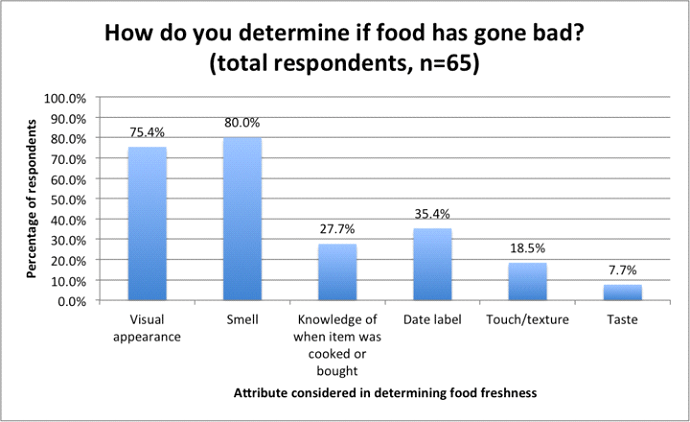
We also analyzed the survey through two other lenses: pace of lifestyle (which was the central focus of our hypothesis), and income (annual household income level). We wanted to see if there were any trends between respondents in these differing categories (Appendix K). Our analysis through these lenses was focused solely on the one type of categorization, not any intersections of the two (i.e. we were not examining whether people who make 40K annually and lead slow-paced lives were behaving differently than people who make 80K and lead fast-paced lives). One observation of the survey responses shows that zero participants in the +35K income group indicated “always” making produce decisions based on seasonal availability. In this same group, zero participants indicated throwing away “a lot” of uneaten food in the previous week.
The purpose of our project was to develop an understanding of food waste in US households. The United States faces a large-scale problem in trying to reduce food waste. In this study, we focused on household behaviors that surround purchasing, storage, and sorting (waste versus non-waste) of food items. All participants in our study were aware that food spoilage is a growing financial and environmental problem. Most had an awareness of how much they contribute to the food waste problem, and most have unsuccessfully tried a variety of methods and strategies to reduce waste or eliminate it altogether.
We identified several common behaviors among our observation participants. First, most food waste resulted from refrigerated items going bad. Most of the wasted items were dairy products, fresh fruits and vegetables, and prepared/home-cooked items. Participants determined what to throw away by physical methods that included touch, sight, smell; visual inspection was used the most often. Of the four participants in our observations, only one participant was sorting items between waste and compost. Total observed interactions totaled 56, 16 of those resulting in waste, and the remaining 40 resulting in no waste (compost or items returned).
We found date labels to be less important to people overall than we assumed. Roughly a third of survey respondents noted it as one aspect that they look at when tossing food, but it was never the only aspect.
Our interview participants reinforced the theme of feeling guilt at personal, wasteful behavior, despite being aware of their own habits’ likelihood to create waste (for example: buying food at bulk-food store Costco, when you’re only shopping for two people). The interviews’ expanded look (over the observations) at shopping and cooking created a more holistic view of people’s lives and how a technology to support them would need to behave. Many people mentioned their busy schedules lead to their lack of planning, lack of cooking, and/or other habits that help food go uneaten. Our potential technological solution would need to address the weak spots in people’s meal or shopping planning in a minimally-invasive, low-input-required way in order to become a habitual feature in users’ lives. Some ideas include a log to reference recent shopping trips or fridge cleans, alerts to clean food storage areas, a recipe resource with easy saving of shopping lists to allow the user to do their shopping trip without having to record all the ingredients required. Our solution could also employ a positive tone overall to emphasize the all-around positive value of limiting food waste (and the guilt that comes with it). Gamification may be successful with this angle.
B. Limitations and Future WorkIn our observations, we suspected that some of the participants may have pre-sorted items or cleaned the food storage areas prior to the observations. Additionally, we observed a very small number of participants, so our findings may not generalize to a larger audience. We also felt it would be helpful to observe these users’ cleaning methods over a longer period of time. By observing our users over a longer period we can make note of changes in ways they discard food. In the future, it would be helpful if we cut down the time commitment for our participants. We noticed that a lot of the participants were short on time due to full schedules. By streamlining the observation, interview and survey processes/questions, thus cutting down the time requirement, we may experience an increase in those who want to participant in our study. Also, it can be argued that shorter interviews and surveys could lead to more truthful answers. Participants may try to rush through their session by giving answers they believe will satisfy the interviewer.
We also discovered that the varied income among our participants may have been a factor that impacted our findings. That is, we suspect that the fact that some participants purchased fresh organic produce that spoiled quicker might have been associated with higher incomes. Conversely, we suspect that our participants with lower incomes tended to buy conventional produce that utilize waxes and pesticides that prolong the lifespan of the produce. Other issues of income may also be related to food waste; e.g. those with higher incomes may also have the opportunity to buy fresh food items multiple times throughout the month, enabling them to be more wasteful, while those who are less affluent may have more canned goods and foods that can be kept for months on end before use. In general, a wealthy consumer would be more inclined to discard perfectly edible food than someone on a lower income who needs to be more careful about how they spend their money. Future work would give us an opportunity to ask questions that will explore other relevant trends we hypothesize might be impacted by income.
For the survey question Please indicate how useful you think each of the following steps is in preventing food waste, we have survey takers rate the option of ‘donate leftover food.’ However, we never define ‘donate.’ If we specify that we mean “donating canned goods to food pantries” that would give the question clarity, instead of requiring the participant to rely on his or her personal definition of donate. In the future we would also alter the exclusionary question of how much uneaten food did you throw away last week. We would change ‘last week’ to ‘within the past 2 weeks.’ The original wording of this question eliminated 15 participants from answering crucial food waste related questions because they stated that they did not throw away any food during that time. Just because someone may have had one waste-free week does not mean that they don’t produce food waste at all. By extending the time period in question from one week to two weeks we could obtain more responses for the survey’s food-waste-related questions, and get greater insight into our respondent group breakdowns by income, lifestyle pace, and more.
ADULT CONSENT TO PARTICIPATE IN RESEARCH
Food Waste Management
Principal Investigator: Nora Hanlon, Rick Borges, Juston Gaughan and Krystal Flowers, graduate students
Institution: DePaul University, Chicago, Illinois, USA
Department (School, College): College of Computing and Digital Media, Human-Computer Interaction
Faculty Advisor: Prof. Cynthia Putnam
What is the purpose of this research?
We are asking you to be in a research study because we are trying to learn more about people’s food waste habits. This study is being conducted by Nora Hanlon, Rick Borges, Juston Gaughan and Krystal Flowers, graduate students at DePaul University, as a requirement to obtain their Master’s degrees. This research is being supervised by their faculty advisor, Cynthia Putnam.
There may be other people on the research team assisting with the study.
We hope to include about 4 people in the research.
Why are you being asked to be in the research?
You are invited to participate in this study because you grocery shop for more than just yourself.
What is involved in being in the research study?
If you agree to be in this study, being in the research involves cleaning out your home refrigerator and any other food storage areas (such as a pantry), and answering some questions about the activity. A researcher will observe these activities.
How much time will this take?
This study will take about 15-20 minutes of your time.
Are there any risks involved in participating in this study?
Being in this study does not involve any risks other than what you would encounter in daily life. You may feel uncomfortable or embarrassed about answering certain questions. You do not have to answer any question you do not want to.
Are there any benefits to participating in this study?
You will not personally benefit from being in this study.
We hope that what we learn will help develop solutions to diminish food waste people create at home.
Can you decide not to participate?
Your participation is voluntary, which means you can choose not to participate. There will be no negative consequences, penalties, or loss of benefits if you decide not to participate or change your mind later and withdraw from the research after you begin participating.
Who will see my study information and how will the confidentiality of the information collected for the research be protected?
The research records will be kept and stored securely. Your information will be combined with information from other people taking part in the study. When we write about the study or publish a paper to share the research with other researchers, we will write about the combined information we have gathered. We will not include your name or any information that will directly identify you. We will make every effort to prevent anyone who is not on the research team from knowing that you gave us information, or what that information is. However, some people might review or copy our records that may identify you in order to make sure we are following the required rules, laws, and regulations. For example, the DePaul University Institutional Review Board.
Who should be contacted for more information about the research?
Before you decide whether to accept this invitation to take part in the study, please ask any questions that might come to mind now. Later, if you have questions, suggestions, concerns, or complaints about the study or you want to get additional information or provide input about this research, you can contact the researcher, .
This research has been reviewed and approved by the DePaul Institutional Review Board (IRB). If you have questions about your rights as a research subject you may contact Susan Loess-Perez, DePaul University’s Director of Research Compliance, in the Office of Research Services at 312-362-7593 or by email at sloesspe@depaul.edu.
You may also contact DePaul’s Office of Research Services if:
Statement of Consent from the Subject:
I have read the above information. I have had all my questions and concerns answered. By signing below, I indicate my consent to be in the research.
Signature:
Printed name:
Date:
Observation script
Pre-Observation:
Hello, _______, I’m ____ from DePaul University, and I’m going to be observing you clean out your refrigerator and pantry today.
First, I want to thank you for agreeing to take part in this study. I have some information for you, and I’m going to read it to make sure that I cover everything. I’m observing people while they clean out their refrigerators and other food storage areas in order to figure out how my team can help eliminate food waste. This observation should not take more than 15 minutes.
I want to stress that I’m just observing how people sort through their food items. This observation is not to judge you. You don’t have to worry about making mistakes because there is no right or wrong answer here. If you would, I’m going to ask you to sign a simple permission form for me. It just says that I have your permission to observe you, and that the information/notes gathered here will only be seen by the people working on the project. Your personal information will be anonymous.
Have participant fill out the permission form.
Okay. Before we begin I would like to ask a few questions:
Pre-Observation Questions:
- What is the size of your household?
- How often do you shop?
- At which stores do you normally grocery shop?
- Approximately how much time do you spend shopping for food?
- What kind of food items do you usually buy during these shopping trips?
- How often do you cook meals from scratch?
- How often is takeout delivered to your residence?
Answer any questions.
Alright, you may now proceed to clean out your refrigerator and other food storage areas.
Allow participant to clean out their refrigerator and pantry until completion.
Post-Observation:
Thank you once again for taking part in this study. This observation has been very helpful. I have a few more questions to ask you before we end this session:
Post-Observation Questions:
- Can you describe criteria you use to determine whether to keep or dispose of food?
a. If they use dates, ask them how. (note: dates vary-- some are “sell by” “use by” “expires” “enjoy by”) - Was there anything about this process that made you feel anxious?
- Is there anything you wanted to do differently during the observation?
- Are there any things that I could do differently?
Answer any remaining questions.
Thank the participant again before you leave.
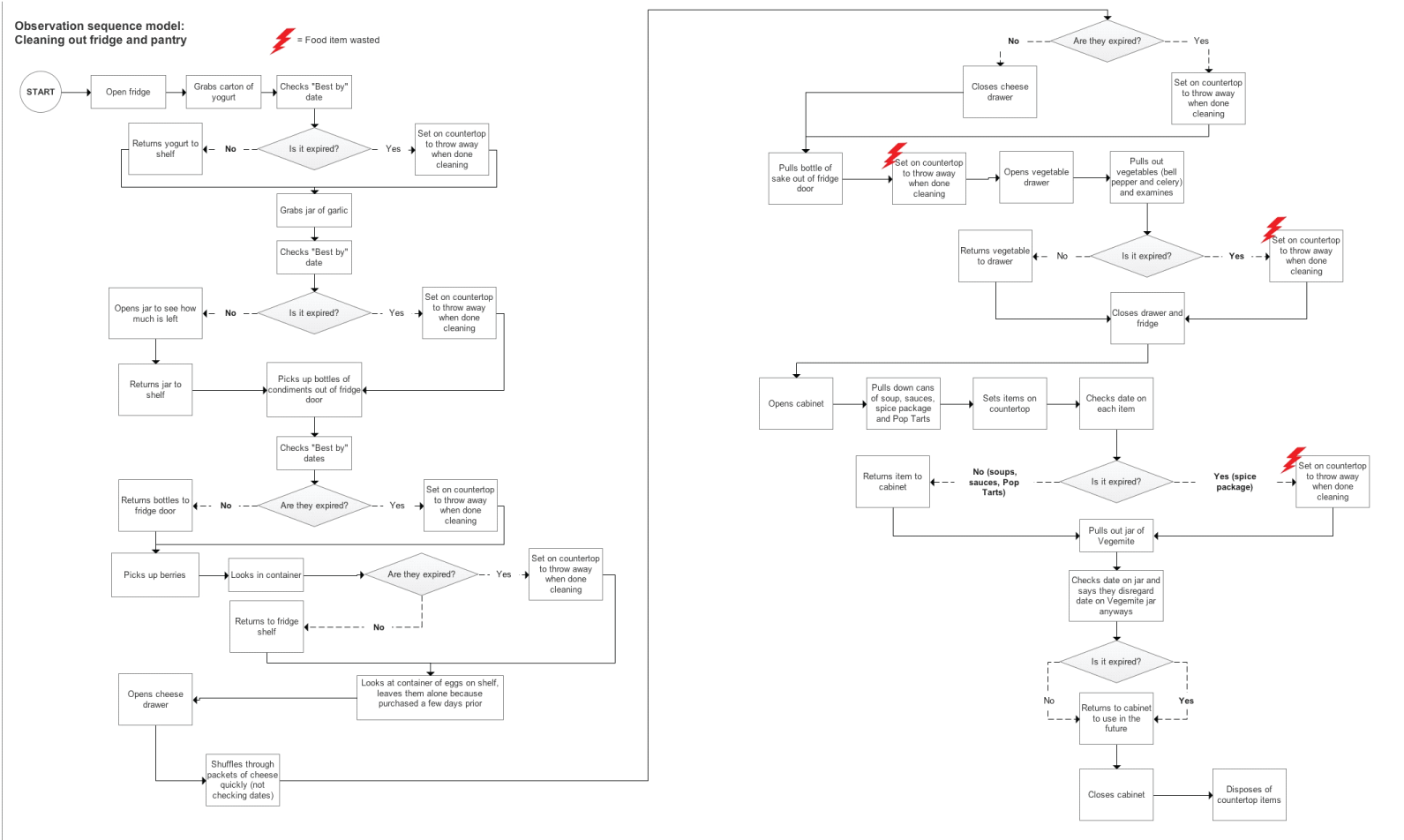
Adult Consent to Participate in Research
Food Waste Management
Principal Investigator: ___________, graduate student
Institution: DePaul University, Chicago, Illinois, USA
Department (School, College): College of Computing and Digital Media, Human-Computer Interaction
Faculty Advisor: Prof. Cynthia Putnam
What is the purpose of this research?
We are asking you to be in a research study because we are trying to learn more about people’s food waste habits. This study is being conducted by Nora Hanlon, Rick Borges, Juston Gaughan and Krystal Flowers graduate students at DePaul University as a requirement to obtain their Master’s degrees. This research is being supervised by their faculty advisor, Cynthia Putnam.
There may be other people on the research team assisting with the study.
We hope to include about 4 people in the research.
Why are you being asked to be in the research?
You are invited to participate in this study because you grocery shop for more than just yourself.
What is involved in being in the research study?
If you agree to be in this study, being in the research involves answering questions about how you grocery shop, cook and manage food in your household, as well as answering some demographic information questions.
How much time will this take?
This study will take about 15-20 minutes of your time.
Are there any risks involved in participating in this study?
Being in this study does not involve any risks other than what you would encounter in daily life. You may feel uncomfortable or embarrassed about answering certain questions. You do not have to answer any question you do not want to.
Are there any benefits to participating in this study?
You will not personally benefit from being in this study.
We hope that what we learn will help develop solutions to diminish food waste people create at home.
Can you decide not to participate?
Your participation is voluntary, which means you can choose not to participate. There will be no negative consequences, penalties, or loss of benefits if you decide not to participate or change your mind later and withdraw from the research after you begin participating.
Who will see my study information and how will the confidentiality of the information collected for the research be protected?
The research records will be kept and stored securely. Your information will be combined with information from other people taking part in the study. When we write about the study or publish a paper to share the research with other researchers, we will write about the combined information we have gathered. We will not include your name or any information that will directly identify you. We will make every effort to prevent anyone who is not on the research team from knowing that you gave us information, or what that information is. However, some people might review or copy our records that may identify you in order to make sure we are following the required rules, laws, and regulations. For example, the DePaul University Institutional Review Board.
Who should be contacted for more information about the research?
Before you decide whether to accept this invitation to take part in the study, please ask any questions that might come to mind now. Later, if you have questions, suggestions, concerns, or complaints about the study or you want to get additional information or provide input about this research, you can contact the researcher, Nora Hanlon, 630-388-8678.
This research has been reviewed and approved by the DePaul Institutional Review Board (IRB). If you have questions about your rights as a research subject you may contact Susan Loess-Perez, DePaul University’s Director of Research Compliance, in the Office of Research Services at 312-362-7593 or by email at sloesspe@depaul.edu.
You may also contact DePaul’s Office of Research Services if:
Statement of Consent from the Subject:
I have read the above information. I have had all my questions and concerns answered. By signing below, I indicate my consent to be in the research.
Signature:
Printed name:
Date:
Research question: How can we alter people’s “throw-away” behavior when it comes to household food waste?
Interview questions:
Introduction
Hello, _______. I’m ____ from DePaul University. Thank you for taking the time to speak with me today. I’m going to ask you some questions to learn about how you approach grocery shopping, cooking, and managing food in your home. Your answers will help our research team develop a solution to aid people in managing food in their home. If you would, I’m going to ask you to sign a simple permission form. On this form you can find the description of our project and our research processes. The form says I have permission to observe you, and that findings and notes gathered here will only be shared with the people working on this project. Any personal information will be kept anonymous.
Have participant fill out the informed consent form.
If you will allow, I would like to audio record this interview for note-taking purposes. Feel free to ask me to stop recording at any time. With that, let’s begin.
Warm Up
Do you think uneaten/unused food in the home is a problem in this country?
Why or why not is this a problem? (It is okay if they don’t know it’s a problem.)
To understand shopping & shopping preparation attitudes
When was the last time you went grocery shopping?
Tell me about your process, for example relevant activities before, during or after your trip.
Probe - How do you determine what to pick up from the grocery store?
Probe - Do you take inventory of any items in the fridge or pantry before heading out grocery shopping?
Was that a typical grocery shopping experience?
IF NOT – how is your typical experience different?
To understand cooking attitudes
When was the last time you prepared food at home?
(If there was a last time) – tell me about that.
Probe for - For yourself? Others?
Probe for – did you use any recipe(s)?
If they cook from recipes-- How do you choose which recipes to cook?
Probe for – do you typically use recipes?
Thinking over the last three months, what are typical of the dishes you make?
Probe for - what produce/perishable items are part of those dishes?
To understand attitudes around using food before it goes bad/adjusting habits
What do you do with leftovers?
Tell me about the last time you had food (that either you cooked or brought home) that you didn’t eat or use?
Do you use any methods to store foods beyond the date on which they might typically go bad?
If not, have you researched or looked into or heard of any methods?
If so, what methods do you currently use and what methods have you tried?
Do you sort through food storage areas (refrigerator, pantry, etc) to remove expired items?
If so, about how often?
To understand attitudes around determining throw-away date of food
How do you determine when food has gone bad?
Do you know any other methods for determining if your food has gone bad?
Do you treat home-cooked food differently than food ordered from a restaurant when determining if it should be thrown away?
If so, how?
Retrospective
What are the consequences of unused/uneaten food?
What are some of the things you do in your own home to prevent wasting food?
In a perfect world, what kinds of tools can you imagine that might help you (and others) waste less food?
Wrap–up
Thank you so much for talking with me. I just have a few more questions.
Which of these options describes your yearly household income before taxes?
Which of these age groups do you fall into?
Do you have any questions for me?
Is there anything you would like to add about food management and food waste in your home?
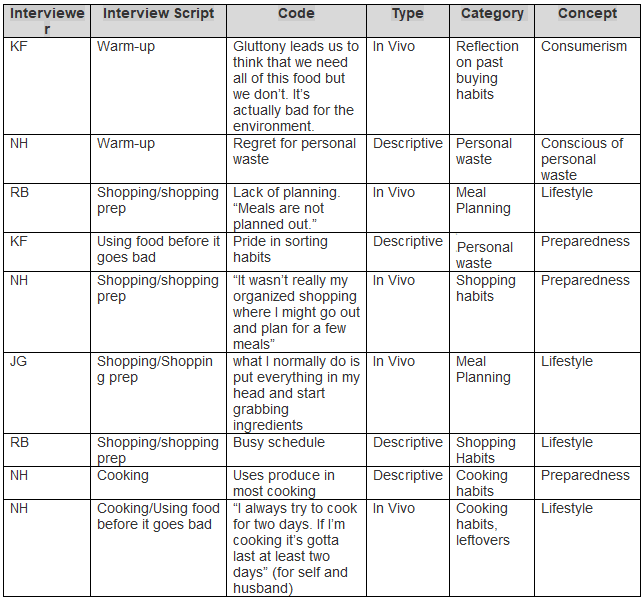
B. Checking refrigerator/cabinets beforehand
C. I don’t prepare
D. Other: __________
Reasoning: Understand shopping preparation
2 Over the last year, I bought more food items than I needed.
A. Always
B. Sometimes
C. Rarely/never
Reasoning: Understand shopping habits
3 Over the last year, did you make produce decisions based on seasonal availability? A. Always
B. Sometimes
C. Rarely/never
D. Opt out- I don’t know
Reasoning: Understand shopping habits
4 With how many people in your household do you currently share groceries?
0 (just me)
1-2
3
4
5+
Prefer not to answer
Reasoning: Attribute Q
5 In the last year, have you cooked for other members of your household?
Yes
No
N/A - I live alone
Reasoning: Understand cooking habits
6 In the last year, about how many meals did you cook per week?
Less than 2
3-5
6-7
8+
I don’t cook
Reasoning: Understand cooking habits
7 In the last year, did you ever cook with the intention of having leftovers?
Yes
No
N/A - I don’t cook Understand cooking habits
8 If food is close to going bad, have you ever taken efforts to use it or preserve it?
Yes
No
[IF NO, THEY WILL SKIP TO #10]
Reasoning: Understand food storage habits
9 Please describe a recent example of an effort you took to use a food that was going bad
Reasoning: Open-ended To get in their words what they have tried to do
10 How do you determine if food has gone bad?
Reasoning: Open-ended To get in their words what they have tried to do
11 How confident are you in your ability to determine a food item’s freshness?
Not at all confident
Somewhat confident
Very confident
Reasoning: Understand food throw away behavior
12 How important is the “Use by Date” label for your household in determining whether food is safe to consume?
A. Not important
B.
C. Somewhat important
D.
E. Very important
Reasoning: Understand food throw away behavior
13 Thinking about the last year, about how often did you keep track of how long food items were stored in the refrigerator?
A. Rarely/never
B. Sometimes
C. Very often
D. I’m not sure
Reasoning: Understand food throw away behavior
14 How often do you check the “Use by Date” or “Sell by Date” labels when grocery shopping?
A. Rarely/never
B. Sometimes/Always
C. I’m not sure
Reasoning: Understand food throw away behavior
15 How much uneaten food did you throw away last week?
A. None
B. Some
C. A lot
D. Not Sure
[IF NONE, THEY WILL SKIP TO DEMOGRAPHICS- #23]
Reasoning: Understand throw away behavior
16 What are methods that you use for discarding food?
Reasoning: Open-ended To get in their own words
17 I compost unused food
A. Rarely/never
B. Sometimes
C. Always
Reasoning: Understand throw away behavior
18 What is the primary reason that you throw away food?
Reasoning: Understand throw away behavior
19 How would you describe the pace of your life over the last year?
A. Extremely slow paced
B. Somewhat slow paced
C. Neither fast nor slow paced
D. Somewhat fast paced
E. Extremely fast paced
Reasoning: Understand waste mood
20 How much do you agree or disagree that food waste is a current problem in you home?
A. Strongly disagree
B. Somewhat disagree
C. Neither agree nor disagree
D. Somewhat agree
E. Strongly agree
F. Not sure
Reasoning: Understand waste mood
21 How do you feel when you throw food away?
Reasoning: Understand waste mood
22 Please indicate how useful you think each of the following steps is in preventing food waste
[Not useful, Somewhat useful, Very useful, I’m not sure]
options:
Buying less food
Better meal planning
Clearer food labels
Donate leftover food
Freeze food before it expires
Monitor food items in fridge/pantry for expiration dates
More frequent cleaning of food storage
Reasoning: Understand food waste mood
23 What is your age group?
A. 18-30
B. 31-50
C. 51-70
D. 71+
E. Prefer not to answer
Reasoning: Attribute Q
24 What is your annual household income? In thousands of dollars per year
Less than 35K
35K-75K
75K-100K
More than 100K
Prefer not to answer
Reasoning: Attribute Q
25 How would you describe where you currently live? Pick the response that best represents your home area
City/urban
Suburban
Rural
Other
Reasoning: Attribute Q
